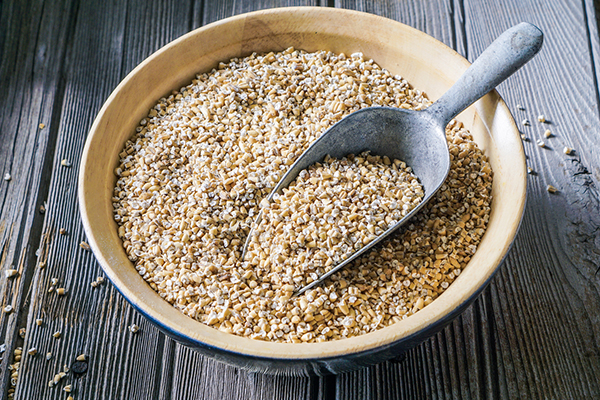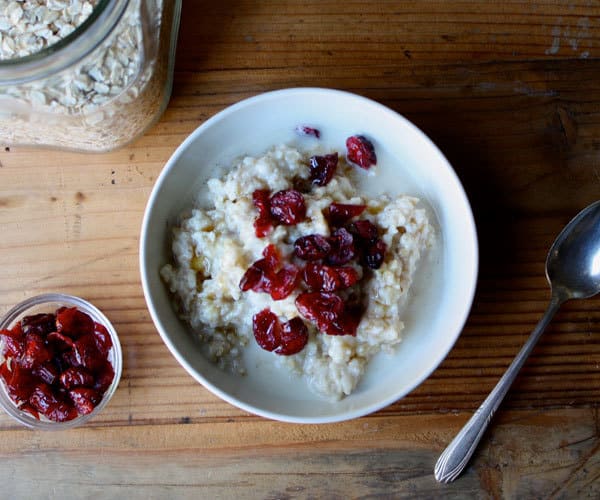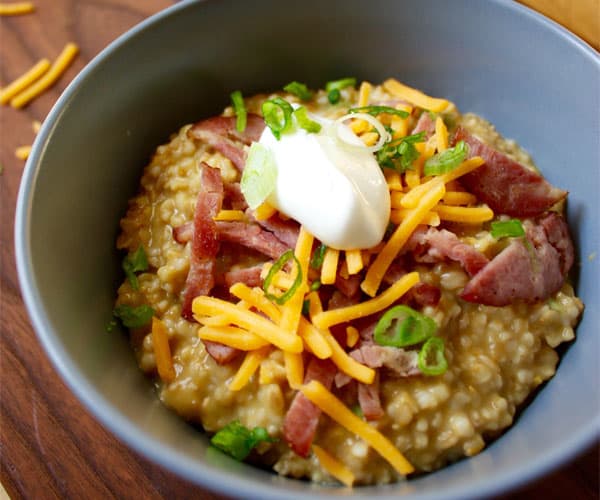How Well Do You Know Your Oats?

Oh, oatmeal: It’s convenient, nutritious, versatile, and comforting.
But choosing what type of oats to eat — what’s the difference between steel-cut, rolled, overnight, and instant?! — can be a far more complicated decision than you’d ever dream of making before 7 a.m.
To help simplify things, we caught up with registered dietitian/nutritionist (and fellow healthy oatmeal enthusiast) Dawn Jackson Blatner.
The Three Oatmeal Types to Know
When it comes down to it, there are three types of oats: steel-cut, rolled — aka, old-fashioned — and instant.
Because all three share the same source (groats, or hulled oat grains), you can rest assured you’ll be getting all of the benefits of a whole-grain breakfast in every one.
The only difference, notes Blatner, lies in the way the oats are cut and cooked — two factors that will play into your own cook time with them.
Here, we break down the basics:

1. Steel-Cut Oats (also known as Irish oats or Scottish oats)
Cook time: 10–20 minutes
When whole groat is cut into small pieces, it’s known as steel-cut oats.
The best thing about this kind of oat is that it soaks up a lot of water — a big benefit, Blatner notes, when it comes to feeling full for more considerable lengths of time.
The downside?
In order to soak up that amount of water they usually require a significant cook time, ranging from 10 to 20 minutes — meaning that these oats likely see more kitchens on lazy Sundays than on manic Mondays.
Pro tip: You can set your rice cooker to the “porridge” setting to cook these to perfection while you’re not even in the kitchen.

2. Rolled Oats (also known as old-fashioned oats)
Cook time: 5 minutes
Instead of being cut with blades like steel-cut oats, these oats are steamed and then rolled, which means two bits of good news: They take less time to cook and you can eat them raw, making them an ideal ingredient in a variety of recipes:
Rolled oats and steel-cut oats are the types used in all those overnight oats recipes you see all over your Instagram feed.
Try these overnight oats recipes:
- Vanilla Peach Overnight Oats
- Strawberry Shakeology Overnight Oats
- Overnight Steel-Cut Oatmeal
- Slow Cooker Banana Bread Oatmeal
3. Instant Oats
Cook time: 1–3 minutes
Instant oatmeal gets a bad rap, and it’s easy to see why: Many of the packaged options out there can contain upward of 10 grams of sugar per pack.
But Blatner says there’s absolutely nothing wrong with indulging in instant oats — so long as you go with the traditional plain oats and add in a touch of sweetness and flavor by way of fresh fruit like apples or a sprinkling of dried fruits.
Pro tip: Remember — sugar is still sugar, even when it’s from a natural, healthy source like fruit, so watch those portions!

Health Benefits of Oatmeal
No matter which oatmeal works for you and your daily grind, each oatmeal type includes the bran, germ, and endosperm.
“When you get a bran cereal, you’re not getting whole-grain nutrition — you’re just getting the benefits of the bran, which is one-third of the whole-grain makeup,” says Blatner.
Oatmeal contains beta glucan, a soluble dietary fiber found in whole grains and oats that is linked to maintaining healthy cholesterol levels.
It also delivers important vitamins and minerals your body needs to function properly, like potassium, magnesium, and folate.
A Balanced Bowl
It might be easy to whip up some oats on-the-go as you rush out the door, but Blatner cautions against keeping things too simple.
“It’s important to remember that it’s not a complete meal on its own, so you need to be sure to incorporate protein and produce,” she says.
Hit all three macronutrients (carbs, healthy fats, and protein) by making it with milk, topping it with nuts, or blending in almond butter, while also ensuring you work in some berries or chopped apple in the process.
To change things up a bit, think eggs: Throw a poached one on top, or mix them in scrambled with some sautéed kale for a savory oatmeal bowl.
Beyond the Bowl
Oatmeal may look like it belongs in a bowl with a spoon, but its kitchen potential is far greater.
Blatner uses rolled oats for a variety of recipes, including smoothies, oat flour (she uses this for pancakes), and protein bites with peanut butter.
You can also use oatmeal in savory meals, too, like this recipe for Savory Irish Oats With Turkey Bacon, Cheddar, and Chives.
Another especially popular way to use oats is as a thickener for soup.
“There are so many fun and clever ways to eat oats,” notes Blatner. “It doesn’t just have to be a hot breakfast bowl.”
Check out these other creative ways to use your oats:
- No-Bake Oatmeal Protein Bars
- Blueberry Oatmeal Muffins
- Baked Oatmeal Cups With Berries and Bananas
- Cashew and Oat Gluten-Free Waffles With Fresh Berries
- No-Bake Shakeology Breakfast Cookies
The Bottom Line
It’s time to look at the bland, boring bowl of oatmeal of your childhood in a new light.
With a few easy tweaks, you can use oatmeal as a base to make creative — and healthy — meals for any time of day.
